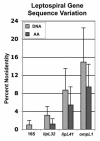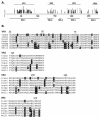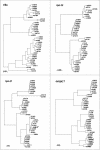Molecular evolution and mosaicism of leptospiral outer membrane proteins involves horizontal DNA transfer
- PMID: 15090524
- PMCID: PMC387810
- DOI: 10.1128/JB.186.9.2818-2828.2004
Molecular evolution and mosaicism of leptospiral outer membrane proteins involves horizontal DNA transfer
Abstract
Leptospires belong to a genus of parasitic bacterial spirochetes that have adapted to a broad range of mammalian hosts. Mechanisms of leptospiral molecular evolution were explored by sequence analysis of four genes shared by 38 strains belonging to the core group of pathogenic Leptospira species: L. interrogans, L. kirschneri, L. noguchii, L. borgpetersenii, L. santarosai, and L. weilii. The 16S rRNA and lipL32 genes were highly conserved, and the lipL41 and ompL1 genes were significantly more variable. Synonymous substitutions are distributed throughout the ompL1 gene, whereas nonsynonymous substitutions are clustered in four variable regions encoding surface loops. While phylogenetic trees for the 16S, lipL32, and lipL41 genes were relatively stable, 8 of 38 (20%) ompL1 sequences had mosaic compositions consistent with horizontal transfer of DNA between related bacterial species. A novel Bayesian multiple change point model was used to identify the most likely sites of recombination and to determine the phylogenetic relatedness of the segments of the mosaic ompL1 genes. Segments of the mosaic ompL1 genes encoding two of the surface-exposed loops were likely acquired by horizontal transfer from a peregrine allele of unknown ancestry. Identification of the most likely sites of recombination with the Bayesian multiple change point model, an approach which has not previously been applied to prokaryotic gene sequence analysis, serves as a model for future studies of recombination in molecular evolution of genes.
Figures





References
-
- Boursaux-Eude, C., I. Saint Girons, and R. Zuerner. 1998. Leptospira genomics. Electrophoresis 19:589-592. - PubMed
-
- Branger, C., C. Sonrier, B. Chatrenet, B. Klonjkowski, N. Ruvoen-Clouet, A. Aubert, G. Andre-Fontaine, and M. Eloit. 2001. Identification of the hemolysis-associated protein 1 as a cross-protective immunogen of Leptospira interrogans by adenovirus-mediated vaccination. Infect. Immun. 69:6831-6838. - PMC - PubMed
-
- Brenner, D. J., A. F. Kaufmann, K. R. Sulzer, A. G. Steigerwalt, F. C. Rogers, and R. S. Weyant. 1999. Further determination of DNA relatedness between serogroups and serovars in the family Leptospiraceae with a proposal for Leptospira alexanderi sp. nov. and four new Leptospira genomospecies. Int. J. Syst. Bacteriol. 49:839-858. - PubMed
Publication types
MeSH terms
Substances
Associated data
- Actions
- Actions
- Actions
- Actions
- Actions
- Actions
- Actions
- Actions
- Actions
- Actions
- Actions
- Actions
- Actions
- Actions
- Actions
- Actions
- Actions
- Actions
- Actions
- Actions
- Actions
- Actions
- Actions
- Actions
- Actions
- Actions
- Actions
- Actions
- Actions
- Actions
- Actions
- Actions
- Actions
- Actions
- Actions
- Actions
- Actions
- Actions
- Actions
- Actions
- Actions
- Actions
- Actions
- Actions
- Actions
- Actions
- Actions
- Actions
- Actions
- Actions
- Actions
- Actions
- Actions
- Actions
- Actions
- Actions
- Actions
- Actions
- Actions
- Actions
- Actions
- Actions
- Actions
- Actions
- Actions
- Actions
- Actions
- Actions
- Actions
- Actions
- Actions
- Actions
- Actions
- Actions
- Actions
- Actions
- Actions
- Actions
- Actions
- Actions
- Actions
- Actions
- Actions
- Actions
- Actions
- Actions
- Actions
- Actions
- Actions
- Actions
- Actions
- Actions
- Actions
- Actions
- Actions
- Actions
- Actions
- Actions
- Actions
- Actions
- Actions
- Actions
- Actions
- Actions
- Actions
- Actions
- Actions
- Actions
- Actions
- Actions
- Actions
- Actions
- Actions
- Actions
- Actions
- Actions
- Actions
- Actions
- Actions
- Actions
- Actions
- Actions
- Actions
- Actions
- Actions
- Actions
- Actions
- Actions
- Actions
- Actions
- Actions
- Actions
- Actions
- Actions
- Actions
- Actions
- Actions
- Actions
- Actions
- Actions
- Actions
- Actions
- Actions
- Actions
- Actions
- Actions
- Actions
- Actions
- Actions
- Actions
- Actions
- Actions
Grants and funding
LinkOut - more resources
Full Text Sources
Other Literature Sources
Molecular Biology Databases

